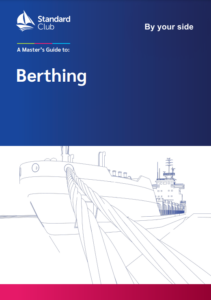The Standard Club issued a guide concerning berthing and best practices, raising awareness of the risks that may arise. This new, updated version includes further content on berthing aids, snap-back zones and bow thrusters, also providing guidance on electronic berthing aids and detailed tug assistance.
Standard Club comments that “Ship handling is an art rather than a science.”
Yet, there are many risks around this operation; Therefore, knowledge of the science will enable easy identification of a ship’s manoeuvring characteristics and quick evaluation of the skills needed for control. A ship handler needs to be able to understand what is happening to their ship and anticipate potential issues to prepare for the situation.
Captain Yves Vandenborn, Director of Loss Prevention states that
Ships can, and do, run aground, demolish jetties, hit the berth and collide with other ships at an alarming frequency, giving rise to loss of life, environmental pollution and property damage.
Golden rules of berthing
According to the guide, there are certain steps to be taken prior to a vessel’s berthing, as such:
Passage planning
- Always passage plan from berth to berth. Pay careful attention to the dangers that are likely to be encountered during the pilotage.
- Always fully brief the pilot, making sure that he understands the ship’s speed and manoeuvring characteristics.
- Always ask the pilot to discuss the passage and berthing plan. Ask questions if anything is unclear.
Working with tugs
- Consider the use of tug assistance, where wind and current or the ship’s handling characteristics create difficult berthing conditions.
- Always estimate windage and use this estimate to determine the number of tugs required.
- When berthing with a bow thruster, a large ship may need a tug to control the ship’s stern.
Manoeuvring
- Avoid high forward speed when:
- working with tugs
- using a bow thruster
- under-keel clearance is small
- sailing in a narrow channel or when close to other ships.
- Test astern movement and wait until the ship moves positively astern before stopping.
- Remember that a ‘kick ahead’ can be used to initiate and maintain a turn when speed is low.
- Remember that the ship’s pivot point is forward of amidships when steaming ahead.
- Remember that a ship will want to settle with the pivot point to the windward of, and in alignment with, the point of influence of wind.
- Remember that the point of influence of wind changes with wind direction and the ship’s heading.
- Remember that at low speed, current and wind have a greater effect on manoeuvrability and that high-sided ships will experience a pronounced effect from leeway.
Finally
- Never ring ‘finished with engines’ until every mooring line has been made fast.
- Always anticipate well ahead and expect the unexpected to occur.
Concluding, Captain Vandenborn highlights that
The guide is unable to cover all the different ship types. Masters must become acquainted with their own ship configurations.
To learn more about the guide, click herebelow


































































